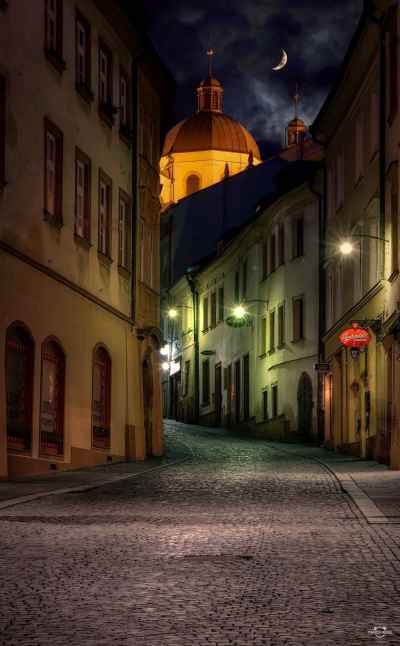In the footsteps of famous peopleMany world-famous personalities have passed through Olomouc throughout history. Well, some of them probably didn't have fabulous memories of Olomouc... Mozart had smallpox, General Lafayette, the hero of two continents, was imprisoned here, King Wenceslas III was even murdered here and Freud experimented with cocaine to survive his stay in Olomouc... Wolfgang Amadeus MozartWolfgang Amadeus Mozart, the famous Austrian composer and piano virtuoso, whose key works include Don Giovanni, The Marriage of Figaro, The Magic Flute, and Cosi fan Tutte, spent several weeks in Olomouc. In May 1767, an epidemic of smallpox broke out in Vienna. Mozart's father decided to move with his whole family to Brno and then to Olomouc. On 26 October they stayed at the inn "At the Black Eagle" (Hauenschild Palace on Dolní náměstí), where the same evening, the eleven-year-old Wolfgang developed symptoms of the disease. The young Mozart continued to compose despite his illness and created his Symphony No. 6 in F major there. Soon the chapter dean, Count Leopold Antonín Podstatský, offered his doctor and family accommodation in the palace of the chapter deanery, where today you can see the unique art exhibition of the Archdiocesan Museum Olomouc. The museum is the only one in the Czech Republic to boast the prestigious European Heritage Label. The Hauenschild Palace no longer houses the "At the Black Eagle" inn, but you can have a good lunch or dinner at the Hanácký restaurant. In addition to Moravian classics in a modern concept, they also offer salads and vegetarian dishes. Sigmund FreudSigmund Freud spent several weeks in Olomouc in 1886 to fulfill his military duty. The only thing that then 30-year-old founder of psychoanalysis found bearable in Olomouc was the good coffee, ice cream, and pastries in his favorite café on Horní náměstí (today's Caffé Opera). There you can also find a memorial plaque dedicated to this famous native of Příbor in Moravia. Freud, who was at the beginning of his career, had to interrupt it as well as postpone his planned wedding in order to attend military maneuvers. According to surviving correspondence, we know that during his short stay in Olomouc, Freud continued his experiments with cocaine, which was gaining popularity at the time. Did you know that...? Freud was also a great lover of Olomouc tvarůžky, which you can buy in many different forms in the company shop right on Olomouc's Horní náměstí. Right next door, we also recommend visiting the Lavender Bistro, where you can get not just good coffee and desserts, exactly as Freud liked it, but also lavender of organic quality in cosmetic and food products made at home. Not only for sweet pastries and fancy coffee, be sure to head to Eatery & Bakery or the museum's Long Story Short Cooking Bar & Café. Gustav MahlerThe Austrian composer Gustav Mahler also briefly worked in Olomouc in 1883. He directed the Vienna Opera for 10 years and then went to the USA as conductor of the Metropolitan Opera and symphony orchestras. He wrote ten symphonies, the last of which remains unfinished. At the age of twenty-two, he underwent a conducting engagement at what is now the Moravian Theatre, commemorated by a bust placed there. However, Mahler was not very happy in Olomouc and was quite critical of the local musicians. In Olomouc, he also suffered as a vegetarian because, in his words, "...they eat only meat here." That is no longer true and you can now enjoy food from a wide range of vegan and ethnic concepts in Olomouc. And you can bet that now Gustav would give the musicians of the Moravian Philharmonic Orchestra a standing ovation...Mahler lived in the house At the Golden Pike, where you can also see his memorial plaque. The house is next to Horní náměstí and nowadays you can stop there (not only) for a sparkling drink at Bubble Wine Bar. LafayetteThe hero of two continents, General Gilbert Lafayette, did not enjoy his holidays in Olomouc but was imprisoned here for several years. That brings us to the somewhat darker corners of the city's history... Lafayette, a close friend of US President George Washington, gained fame during the Great French Revolution and the American freedom struggle. Washington was even said to have been behind the Freemason conspiracy to free Lafayette from the Olomouc fortress. The dramatic escape attempt took place on November 8, 1794, but due to a misunderstanding of the instructions, it did not go well for the general. Lafayette set out that day with a military escort on a medical ride in a carriage. He was to be liberated by the German physician Justus Bollmann with the American medical student Francis Huger. They ambushed the carriage as it was leaving the town in the direction of Šternberk and a scuffle ensued. Lafayette was bitten on the finger by a guard when he tried to silence him with a handkerchief. An article of Lafayette's finger had to be later amputated. As soon as Lafayette mounted his horse, Bollmann gave the general the money and shouted "Get to Hof!" (But Lafayette understood the instruction as "Get off!" (Get off) and did not turn off to Dvory (Hof in German), but rode on to Šternberk. This proved disastrous, for he was recaptured and thrown into the Olomouc prison, where he spent nearly three more years before being released. But you certainly won't go wrong if you head to Šternberk yourself and see the local castle, the multimedia exhibition Ecce Homo Park, or the Exposition of Time! A street leading from the Lower Square in Olomouc is named after Lafayette. The neighboring Uhelná Street is considered the current epicenter of Olomouc's nightlife, along with the passage lined with bars (Masné krámy). Here you can remember the famous general by raising your glass in a toast. TIP! When you turn from Lafayette Street to Šemberova Street, you will meet the movie Alien! The metal sculpture on the roof of one of the houses stands out, especially in the night light, and is definitely worth a photo. Jan SarkanderPerhaps every European town is in some way connected with various saints. Apart from St. Pauline, the patron saint of Olomouc, the city is tied to the personality of the priest Jan Sarkander. He was not only imprisoned in Olomouc but even tortured to death. The times were bad and full of intrigue when Sarkander got accused of allying with the enemy, spying, and plotting against the Protestant nobility's uprising. The priest tried to hide out in the castle of Tovačov but was betrayed, subsequently arrested, and sent to prison in Olomouc. In prison, Sarkander was subjected to four interrogations using torture in the course of only a few days. Even the most horrible practices, however, did not open his mouth. The torture caused a number of serious injuries, and he in consequence in the dungeon less than four weeks later. On the site of the former prison, you will today find the Chapel of St. Sarkander and in it the original torture machine. You will discover the chapel as you make your way through the narrow romantic streets below St Michael's Church. John Sarkander was canonized in 1995, on the occasion of Pope John Paul II's visit to Olomouc. Václav III.Olomouc has many dark stories, including unsolved murders. One of them involves the King of Bohemia, Poland, and Hungary - Wenceslas III. The sixteen-year-old Wenceslas went to Olomouc in 1306 to raise an army he had requested from the nobility. The situation was tense, and the young king was in danger of losing control over the territory of Poland. He wanted to prevent this by a military campaign. Due to the poor cash flow of the royal treasury, Wenceslas wanted to force the nobility into the field of war, and at their own expense no less. Of course, the nobility didn't like that at all... So one hot summer day, while waiting for Moravian reinforcements, the king went for a walk through the palace to get some fresh air. In the shadows, an assassin was waiting for him. According to the Zbraslav Chronicle, he stabbed Wenceslas three times in the chest with a knife. Dalimil's Chronicle mentions a slit throat. Either way, the king was dead! The likely murderer was Conrad of Bodenstein, alias Mulhowu, who was caught and put to death after the crime. The murder was thus not further investigated any further. It is, however, believed that Conrad was hired by the disgruntled nobility to avoid participation in the campaign. The actual act of murder probably took place in the western part of today's deanery building - the seat of the Archdiocesan Museum Olomouc. |
The system of interactive links for individual records in selected modules within the project Central Moravia - mainly quiet (2024) was implemented with the support of the state budget of the Czech Republic from the programme of the Ministry for Regional Development.
The optimization of the website and the online campaign within the project Adrenalin after ours (2023) were realized with the contribution of the state budget of the Czech Republic from the programme of the Ministry for Regional Development.
The website was created within the framework of the project Marketing TO Central Moravia 2020 implemented with the contribution of the state budget of the Czech Republic from the programme of the Ministry for Regional Development.
The operation and activities of Střední Morava – Sdružení cestovního ruchu (Central Moravia – Tourism Association) were supported by funds from the Czech Republic's state budget under a program of the Ministry of Regional Development of the Czech Republic.
The optimization of the website and the online campaign within the project Adrenalin after ours (2023) were realized with the contribution of the state budget of the Czech Republic from the programme of the Ministry for Regional Development.
The website was created within the framework of the project Marketing TO Central Moravia 2020 implemented with the contribution of the state budget of the Czech Republic from the programme of the Ministry for Regional Development.
The operation and activities of Střední Morava – Sdružení cestovního ruchu (Central Moravia – Tourism Association) were supported by funds from the Czech Republic's state budget under a program of the Ministry of Regional Development of the Czech Republic.






























